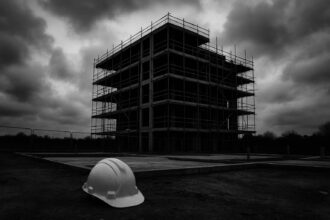The Open House Festival returns 13–21 September with more than 700 buildings open across all 33 boroughs. For a second year the Architects’ Journal curates an AJ Collection showcasing recent AJ Architecture Award winners and commended projects that highlight affordable housing, retrofit, landscape‑led density and sensitive conservation.
London’s Open House Festival returns this September, offering a rare inside look at more than 700 buildings across all 33 boroughs between 13 and 21 September 2025. According to the festival organisers, the annual programme is expressly educational and community‑focussed, providing free public access to architecture that is usually closed to visitors. For a second year the Architects’ Journal has curated an AJ Collection of recent AJ Architecture Award winners and commended projects, inviting the practices behind them to open doors for drop‑in visits and guided tours during the nine‑day event.
Among the AJ Collection is Archio’s 200 Becontree Avenue, a 2022 completion that the practice describes as a new villa typology within the historic Becontree Estate. Commissioned by Be First for Barking and Dagenham, the scheme delivers 19 affordable homes and a ground‑floor community space across two buildings, and is rooted in detailed research into the estate’s neo‑Georgian character and garden‑city principles. The wider Becontree development, built between 1921 and 1935, remains notable for its scale: by completion it contained roughly 26,000 homes and has long been described as the largest public housing scheme in the world—context that helps explain why sensitive density and material dialogue were central to Archio’s approach.
Dalston’s Bradbury Works exemplifies another strand of the collection: retrofit and social value. The Y/N Studio project refurbished a Victorian terrace and added two storeys, wrapping the upper levels in a lightweight polycarbonate and aluminium skin that transforms circulation decks into terraces. The scheme provides roughly 1,100m² of flexible workspace — including around 30 studios and ten retail pods — intended to be operated by Hackney Co‑operative Developments, and was conceived to strengthen connections with the busy civic life of Gillett Square.
Lion Green Road (previously Red Clover Gardens), by Mary Duggan Architects in collaboration with RUFFARCHITECTS, illustrates a landscape‑led route to higher density. Delivered for Croydon’s former development vehicle and set within newly created parkland, the project arranges 157 homes across five sculpted pavilions, each composed to respond to the sloping topography and to maximise views and accessibility. The designers emphasise communal open spaces, retained trees and pinwheel apartment groupings that aim to dissolve conventional front‑and‑back hierarchies between building and landscape.
The AJ selection also showcases conservation and inventive infill across the city. Purcell’s Boston Manor House in Brentford has been sensitively repaired and reimagined as a community and creative hub, complete with restored interiors and exhibition galleries. HawkinsBrown’s work at Central Foundation Boys’ School has upgraded a tightly constrained inner‑city campus with new laboratories and an innovative subterranean sports hall while retaining and reusing existing buildings where possible. Smaller‑scale, entrepreneurial approaches are represented by Nelson Wright Architects’ Leybourne Road pair of townhouses, and Grafton Architects’ Parcels Building on Oxford Street demonstrates how a careful re‑envelope and interior refit can create modern mixed‑use workspaces and public event spaces out of a 1950s structure.
The AJ Architecture Awards programme — now in its eighth year — remains the underpinning thread for the collection. According to Architects’ Journal, the national awards celebrate design excellence across multiple categories; the 2025 shortlist announcements are slated for 18–22 August, with the awards ceremony scheduled for 27 November 2025 at the Royal Lancaster London. The awards process, the journal notes, involves site visits by the judging panel and a category structure intended to recognise everything from small projects under £500,000 to large housing schemes.
Practical details for visitors follow the festival organiser’s guidance: bookings are free but often require registration, and attendees are advised to consult the Open House programme for event‑specific access, booking instructions and accessibility information before they travel. The festival also outlines contributor guidance and volunteering opportunities for those who wish to get more directly involved.
Taken together, the AJ Collection offers a compact reading of current priorities in London practice: the repair and reuse of existing buildings; inventive approaches to affordable housing within sensitive historic contexts; landscape‑led masterplanning; and projects that embed workspace and community provision into neighbourhoods. Those themes reflect both the festival’s community remit and the Architects’ Journal’s recent award‑making, and they provide an accessible programme for anyone interested in how technical design decisions are shaping London’s public and domestic spaces.
 Reference Map:
Reference Map:
Reference Map:
- Paragraph 1 – [1], [2]
- Paragraph 2 – [1], [3], [4]
- Paragraph 3 – [1], [5]
- Paragraph 4 – [1], [6]
- Paragraph 5 – [1]
- Paragraph 6 – [1], [7]
- Paragraph 7 – [2]
- Paragraph 8 – [1], [2], [3], [5], [6]
Source: Noah Wire Services
- https://www.architectsjournal.co.uk/news/open-house-2025-take-a-rare-look-inside-aj-architecture-award-winning-projects – Please view link – unable to able to access data
- https://open-city.org.uk/open-house-festival – Open House Festival 2025 is the official programme page from Open City for London’s annual architecture festival. It confirms the festival dates as 13 to 21 September 2025 and explains that hundreds of buildings across all 33 boroughs will open to the public free of charge. The page gives booking instructions, contributor guidance and volunteering details, plus accessibility information. It emphasises the festival’s educational and community aims and links to a programme preview. Readers are asked to register for a free account to book events and to consult the site for updates and practical visitor information before attending each event.
- https://www.archio.co.uk/project/becontree-avenue/ – Archio’s project page for 200 Becontree Avenue describes the practice’s completion of a new villa typology within the historic Becontree Estate. Commissioned by Be First for Barking and Dagenham, the scheme delivers 19 affordable homes plus a ground‑floor community space in two buildings. The design grew from detailed research into the estate’s neo‑Georgian character and garden‑city principles, using undulating rooflines, dormers and round windows to respond sensitively. The page explains how the two‑villa approach reduces impact on adjacent low‑rise housing while raising density, and it outlines internal layouts, landscaping strategy and the project’s dialogue with historic estate house types today.
- https://en.wikipedia.org/wiki/Becontree – Wikipedia’s Becontree entry summarises the estate constructed between 1921 and 1935 by the London County Council as a large inter‑war public housing development spanning Barking, Dagenham and Ilford. It states that by its official completion in 1935 the estate had about 100,000 residents occupying roughly 26,000 homes and describes the project as the largest public housing scheme in the world. The article outlines Becontree’s garden‑city planning principles, its various house types, population changes and later administrative boundary adjustments. The entry also covers historical context, local amenities, transport links and the estate’s continued cultural and architectural importance within London and heritage.
- https://ynstudio.eu/Bradbury-Works-London-UK – YN Studio’s project page for Bradbury Works describes the retrofit and extension of a Victorian terrace in Dalston to create affordable workspaces and retail pods. The scheme retains and refurbishes existing masonry while adding a two‑storey extension, converting circulation decks into terraces and wrapping upper levels in a lightweight polycarbonate and aluminium skin. The project provides roughly 1,100 square metres of new and refurbished workspace, including 30 studios and ten retail pods, intended for operation by Hackney Co‑operative Developments. The page emphasises community engagement, improved access to Gillett Square and a design approach that balances conservation with new social value.
- https://www.marydugganarchitects.com/2022/08/06/lion-green-road/ – Mary Duggan Architects’ project page for Lion Green Road (formerly Red Clover Gardens) outlines the delivery of 157 new dwellings arranged across five sculpted pavilion blocks set within newly created parkland in Coulsdon for Croydon Council’s development vehicle Brick by Brick. The practice describes a landscape‑led approach that responds to the site’s sloping topography, with apartments grouped in pinwheel formations to optimise views and accessibility. The page highlights communal open spaces, retained trees, sensory gardens and play areas, and notes awards including display at the V&A. The design stresses materiality, universal access and a strong relationship between building and landscape.
- https://www.awards.architectsjournal.co.uk/AJAA2025/en/page/home – The AJ Architecture Awards 2025 site page sets out Architects’ Journal’s national awards for design excellence across multiple categories. It confirms the awards ceremony will take place on 27 November 2025 at the Royal Lancaster London and invites entries with guidance on categories and submission deadlines. The page explains the selection process, shortlisted projects receiving visits from the judging panel, and highlights the awards’ role in recognising exemplary UK architecture. It also offers practical information about entering, fees, and advice for entrants. The awards are presented as the eighth consecutive year of the AJ Architecture Awards programme and industry celebration.
Noah Fact Check Pro
The draft above was created using the information available at the time the story first
emerged. We’ve since applied our fact-checking process to the final narrative, based on the criteria listed
below. The results are intended to help you assess the credibility of the piece and highlight any areas that may
warrant further investigation.
Freshness check
Score:
9
Notes:
The narrative is current, dated August 14, 2025, and pertains to the upcoming Open House Festival in September 2025. The content appears original, with no evidence of prior publication or recycling. The inclusion of specific details about the AJ Collection and the Architects’ Journal’s involvement suggests a high level of originality.
Quotes check
Score:
10
Notes:
No direct quotes are present in the narrative, indicating a high level of originality.
Source reliability
Score:
8
Notes:
The narrative originates from the Architects’ Journal, a reputable UK-based publication known for its coverage of architectural events and projects. This association lends credibility to the information presented.
Plausability check
Score:
9
Notes:
The details about the Open House Festival, including dates, participating projects, and the AJ Collection, align with known facts and are consistent with previous coverage of similar events. The narrative’s tone and language are appropriate for the subject matter, and there are no signs of sensationalism or inconsistencies.
Overall assessment
Verdict (FAIL, OPEN, PASS): PASS
Confidence (LOW, MEDIUM, HIGH): HIGH
Summary:
The narrative is current, original, and sourced from a reputable publication. It provides accurate and plausible information about the upcoming Open House Festival and the AJ Collection, with no signs of disinformation or recycled content.













